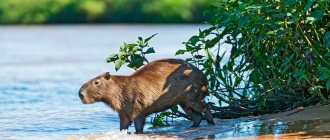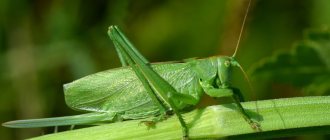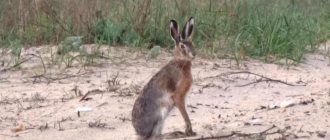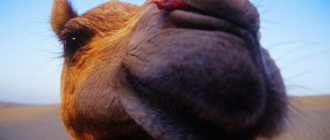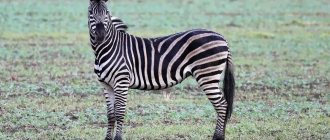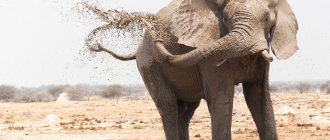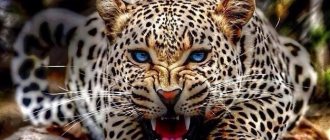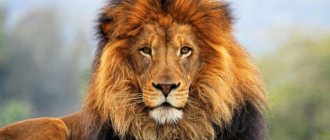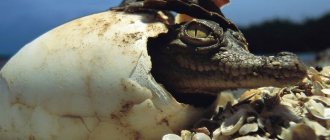The capybara is a mammal that belongs to the rodent order, just like mice, rats, domestic coffee pigs (also known as guinea pigs), chinchillas and squirrels. However, compared to the species mentioned, capybaras are very large animals. They can weigh up to 65 kg! The first mentions date back to the second half of the 18th century. They were described by the famous Swedish naturalist Carl Linnaeus. Interestingly, he included them in the pig family, which is why the capybara was considered a species of pig for many years. For this reason, rodents are still often called water pigs. The name "capybara" in Guarani means a creature that eats grass.
Origin
Capybaras originate from South America. In nature, they live mainly in wetlands - in the equatorial and monsoon forests of Colombia, Brazil and Venezuela. Because they easily adapt to different conditions, they can also be found in Argentina and Uruguay. Rodents choose areas near water bodies. They also tend to stay in human settlements, where they have plenty of food and are less exposed to danger from predators. The animals are not reared on a mass scale, although farms of these animals can be found in South America. They are stored there for the purpose of shelter. An even rarer occurrence is breeding as pets. These exotic creatures can often be found in zoos.
Appearance size
There are two types of rodents - large and small. The latter is limited to Panama and northern Colombia. Therefore, when talking about a capybara, we most often mean the large capybara, which is usually found in South America. This is the largest living rodent. Reaches its own weight up to 65 kg (the record holder weighed 91 kg!). Its length is on average 120 cm, and its height at the withers is up to 65 cm.
They have a rather stocky body structure, a large head with eyes, nostrils and small ears located at the top, which makes it easier for the animal to swim. The short, strong front legs are four-toed and the hind legs are three-toed with claws and a rudimentary tail. Capybaras' toes are connected by webbing, another feature that makes capybaras excellent swimmers.
Like all rodents, they have strong incisors that will last a lifetime. This animal is endowed with excellent vision, hearing and smell. The capybara's skin is thin, brown, covered with sparse, coarse hair with a red-brown color on the back and yellow-brown on the belly. Unlike other rodents, sweat glands are found in the skin of capybaras. Males have scent glands on their faces, from which yellowish secretions with a musky odor come out during the mating season to attract females.
What does it eat?
Capybaras are herbivores and very “picky” animals - most of their diet consists of only a few species of plants. Capybaras feed mainly on coastal grasses. Moreover, they are coprophagous - they obtain some of their nutrients from their own excrement. Because large rodents sometimes destroy human crops in search of food, capybaras are considered pests in South America.
Lifestyle
They live near bodies of water. This allows them to cool down in hot weather, since thin hair does not provide them with enough protection from the sun. During the hottest part of the day, capybaras usually do not leave the water, which is also an excellent shelter from predators. These rodents are excellent swimmers and can hide under water for up to 5 minutes when attacked. Capybaras don't cope as well on land as they do in water—they run rather clumsily, don't dig holes, and can only hide from threats in tall grass.
These are herd animals. They usually live in family groups consisting of one male, several females and cubs - about 10-30 individuals in total. In a threatening situation, for example, during a drought, they can form even several times larger herds. Capybaras communicate using original sounds, which are the subject of research by scientists.
How does it reproduce and how long does it live?
Capybaras reach reproductive capacity at approximately 1.5 years. They can breed all year round. Mating occurs in water. Pregnancy in capybaras lasts 5 months, and up to 7 cubs are born in a litter (usually 3-5). They remain for 2-4 months under the care of their mother, but can be fed by all the females in the herd. Females do not build nests or protect their young in any way, so in nature most of them fall prey to predators.
An adult capybara lives on average 4 years, although in optimal conditions it can live up to 10 years. Rodents often suffer from vitamin C deficiency, are susceptible to numerous infections and, above all, are easy prey for many predatory animals (including jaguars, anacondas and eagles). Wild capybaras are also often killed by humans.
Is it possible to tame a capybara?
These rodents are very smart, social animals. They are easy to tame and can even be taught to follow simple commands. Unlike many other species of exotic animals, capybara breeding is legal in Russia. Unfortunately, keeping them at home is almost impossible. Capybaras need a lot of space and many requirements that must be met in order to be healthy and happy.
First of all, these animals cannot be bred alone. They need their herd because loneliness is a big source of stress for them. In summer, they should have a fenced area (at least 20 sq.m per couple), with constant access to the shade and a pond at least 3 meters deep. In winter they cannot be outside because they are too cold. Capybaras also need to be provided with special food, which is not usually available in Polish stores. Natural grazing is too risky, as rodents have a very sensitive digestive system and can easily become poisoned.
photo source
Interesting Facts
He is about the same size as a Labrador Retriever.
They are capable of speeds of up to 35 kilometers per hour. Like a very fast running man.
They like to express themselves by mumbling, whistling, whining, and even biting with their teeth, depending on what they are trying to convey.
Just like rabbits, their long teeth are ideal for cutting food.
They can dive and stay underwater for up to 5 minutes, often falling asleep in the water, keeping their nose on the surface of the water.
Although their population is believed to be stable, in some areas the animals are seriously threatened by people who hunt them for their skin.
They feed on grass and aquatic plants, eating 3-3.5 kg per day.
Females are heavier than males.
The scientific name (Hydrochoerus) comes from the Greek words (hýdor - water) and (choíros - pig).
The largest individual living in the wild weighed 91 kg.
Animals have 4 toes on their front legs and 3 on their hind legs.
Front teeth grow throughout your life.
They eat their excrement, which is a source of bacteria in the intestinal flora.
Feeling danger, it can start barking like dogs.
They love to cuddle with most friendly animals.
Interesting for you:
Keeping a capybara at home
Small capybaras
The animal is very friendly, affectionate, has a wonderful character, but it is demanding in terms of living conditions. Capybaras need space, so they need to be bred by providing sufficient territory where grass grows and there is a thornless bush. Under it, the capybara will be able to hide from the sun and also gnaw on twigs. She needs this because she needs to grind down her constantly growing teeth. If there is no bush, then tree branches must be periodically placed in the pen. An essential condition for keeping capybaras is a swimming pool. It should be spacious so that the capybara can swim whenever she wants, dive without limiting her movement. During the cold season, the capybara is kept in a warm, spacious indoor area, where there is a heated pool and enough light.
The capybara is unpretentious in food; it eats mainly grass, grain, zucchini, melon, and aquatic plants. If you decide to keep an animal at home, feed it with granules for rodents, which contain the necessary minerals and vitamins, fruits and vegetables, and also hay in the cold season. Sometimes give them vitamin C. If you do not plan to breed capybaras, when is it better to castrate the male, since, having entered puberty, he may perceive his owners as an object of courtship. In captivity, capybaras live 12 years. Capybaras are quite smart animals and can be taught some simple tricks. They love to lay their head on their owner's lap to be scratched and petted. Capybaras love to have their bellies stroked; such caress often makes them fall asleep.
If you want to keep a capybara at home, you must be sure that the animal is completely healthy. After all, they can be carriers of diseases dangerous to humans, for example, spotted fever. The disease is transmitted to humans by the ixodid tick, which parasitizes the capybara. Based on this and the fact that capybaras need special living conditions, it is better to admire them in a zoo or remotely by watching a video where this charming creature plays the leading role.
Capybara and monkey
Mice of Gough Island
Situated in the South Atlantic, Gough Island has been overrun by approximately two million mice. Uninhabited areas have become an ideal breeding ground for them. It is noteworthy that rodents are twice as large as their counterparts living in the civilized world. Every year, 1.6 million petrel chicks are born on the island, and 1.2 million of them are eaten by mice.
Shearwaters are also eaten by black rats that have settled on the Tristan da Cunha archipelago, where, as on Gough Island, these rodents have no natural predators. Experts, in turn, continue to search for the best method for exterminating these pests, because even one surviving pregnant female can give birth to new rats that will multiply quickly. But scientists do not lose hope. In 2009, complete eradication of rats was achieved on Rat Island (Alaska), where rodents lived for 230 years.
Capybara is the largest rodent in the world
The scientific name of the animal is Hydrochoerus (water pig). She is the only representative in her family. The Indians call this animal guar “lord of herbs.”
Capybara (capybara in English) is a very interesting animal, a herbivorous mammal. This is a close relative of guinea pigs, similar in appearance to them, but much larger. Unlike guinea pigs, capybaras adore the water element, therefore they are classified as semi-aquatic mammals.
The capybara lives in the tropical zone of South and Central America, in the Amazon, La Plata and Orinocco river basins. Distribution is limited by climatic conditions. An important factor for life is the temperature of the water in their habitats. The animal uses it for thermoregulation in the heat.
An adult reaches a length of 100-135 cm. Height at the withers is up to 60 cm. The weight of an adult female ranges from 28 to 67 kg, and of a male – from 30 to 63 kg. The largest rodent was recorded at 70 kg.
The capybara's fur resembles that of a beaver - it is just as tough. The length of the brown hair is from 3 to 12 cm (they only have this color).
Gerald Durrell (English writer, founder of the Jersey Zoo and the Wildlife Conservation Fund), describing this animal, said that it is a good-natured, phlegmatic vegetarian with a calm and friendly disposition.
The animals are excellent swimmers; their eyes and nostrils are located in such a way that when they are in water, it does not get into them. If a capybara notices a dangerous enemy, it will almost completely hide in the water, only its nostrils through which it breathes will be visible.
The capybara has 20 teeth in its mouth, which grow throughout its life. This feature, characteristic of the family of rodents, causes the capybara to constantly grind them down on pieces of wood or branches.
The forelimbs end in a 4-fingered hand with claws resembling hooves. There are 3 toes on the hind legs. The phalanges are connected by membranes, which allow the animal to move deftly in the water. On the ground, the rodent moves with a shuffling gait, waddling or skipping.
The capybara is a collective animal. It cannot live separately from the group. The family usually numbers about 20 individuals. 6 – 8 females and cubs are grouped around the dominant male.
This rodent easily adapts to life in captivity. The animal's lifespan is 9-10 years, and in artificially created conditions - up to 12. The animal behaves very calmly towards its owners. She loves affection, loves being scratched on the belly and is ready to spend a lot of time near her owner, laying her head on his lap.
The capybara is patient and will never bite. He loves to play with children. She is smart and able to learn simple circus tricks. The animal obeys its owner and enjoys walking on a leash.
They love to lay their head on their owner's lap to be scratched and petted. Capybaras love to have their bellies stroked; such caress often makes them fall asleep.
Feeding the animal is also not difficult. Hay, fruits, grass - all this is suitable for a rodent's diet. You can purchase special food that is sold in specialized stores.
The capybara is picky about living conditions. Capybaras need space, so they need to be bred by providing sufficient territory where grass grows and there is a thornless bush. Under it, the capybara will be able to hide from the sun and also gnaw on twigs.
If there is no bush, then tree branches must be periodically placed in the pen. An essential condition for keeping capybaras is a swimming pool. It should be spacious so that the capybara can swim whenever she wants, dive without limiting her movement. During the cold season, the capybara is kept in a warm, spacious indoor area, where there is a heated pool and enough light.
The price of a capybara in Moscow is about 90-120 thousand rubles; throughout Russia the price can jump up to 150 thousand rubles. As a rule, it is difficult to buy a capybara from hand; you need to place an order in specialized pet stores.
Socialization
Capybaras live in large families of 10-20 individuals each. The main one in this group is the dominant male, who controls other males, females and cubs. About 10% of these rodents live alone. This can happen if the main male drives out another, whom he considers a competitor. In this case, the expelled animal is forced to live independently.
During dry periods or in places where there is a shortage of water, animals may gather in flocks. One such flock can contain several hundred rodents, which occupy an area of 5-10 hectares.
To communicate, they use peculiar whistling, clicking and barking sounds.
Where can I read about capybaras?
Want to know more about Japanese capybaras? Even more? There are a number of blogs run by true fans of these animals. They know the names, personalities and family histories of individual capybaras at various zoos and parks across the country. Here are some examples (unfortunately, almost all in Japanese):
Capybara Camera (in Japanese); Capybara Engine (in Japanese); Masaki Tokutomi's capybara blog (in Japanese); Capybara World (in English).
There is also an incredibly detailed resource called capybara.eek.jp, which contains almost all the places where you can see capybaras in Japan. It's in Japanese, but you can try translating it into Google Translate and start your capybara pilgrimage.
Plus, capybara.eek.jp also has a list of places you can go to see onsens with capybaras. So what are you waiting for? Go!
In order not to miss interesting publications from the world of travel, subscribe to our groups in and, read the Telegram channel, and look for beautiful pictures on Instagram.
Speckled gopher
The speckled gopher or prairie dog is the most common rodent in Eastern Europe, the banks of the Danube and Volga. They also inhabit countries such as Belarus and Ukraine. Speckled gophers live in dry meadows, forest belts, plantings and near water bodies. The body length of a mature prairie dog reaches 25 centimeters, and its weight does not exceed 700 grams. The gopher, having left its parent's nest, begins to equip its house. In it he raises offspring, spends the summer and hibernates.
Description and dimensions
The capybara has short limbs ending in partially webbed toes. The forelimbs are characterized by the presence of four fingers, while the hind limbs have three fingers. The fingers have short and powerful claws. Unlike some rodents, the capybara does not have a tail.
Capybara
The capybara has a broad head with short, rounded ears, a large snout, and small, widely spaced nostrils. This large rodent is covered with coarse hair, 30 to 120 mm long. The color of the animal ranges from dark brown to reddish and from light brown to light yellow. The hairs are covered by sweat glands that are unique to capybaras. These animals are the only rodents that have sweat glands in their hair.
Hydrochaeris hyrochaeris weighs on average between 35 and 65.5 kg and has a body length of up to 1.35 m. Males have sebaceous glands on the top of the snout, a feature that indicates their sexual maturity. There are six pairs of nipples on the female's belly. The genitals of both sexes are hidden, making it difficult to determine the sex of the animal. Males' incisors are usually larger and wider than those of females of the same age.
Capybara grazing
Appearance
To imagine a capybara, it is enough to imagine a guinea pig fattened up to 40-65 kg (and females can be even larger), grown to 50 cm in height and 1-1.3 m in length.
The heavy, deceptively appearing clumsy and clumsy animal has a barrel-shaped body, a large, almost rectangular head and an inconspicuous tail (many travelers noted in their descriptions that the animal does not have a tail at all). Due to the short legs, the abdomen is close to the ground, and due to the structural features of the front and hind limbs, it seems that the animal is also crouching.
The capybara spends a lot of time in the water, and nature has helped it adapt to such living conditions. Its small eyes are located very high on its large head, and its ears are small and round, which allows it to keep its organs of vision and hearing above the water when swimming. Nose - nostrils-slits located at the end of a blunt muzzle. They are able to close when submerged.
The paws end in webbed toes, like all waterfowl, and end in powerful claws.
The capybara has 20 teeth. The front incisors are slightly forward, like all rodents, and are very sharp. The cheek teeth have no roots and grow throughout the animal's life. Using incisors, the animal cuts the plant and crushes it with its cheek teeth.
The body of the pig is covered with hard and long (up to 12 cm), brown-brown hair, sparse, without undercoat, and therefore the animal hides from direct sunlight or prefers to roll out in the mud. Cubs have lighter fur.
Cute pet
Before purchasing a capybara to live at home, you need to weigh your options and decide whether you can provide your pet with what it needs.
Namely:
- temperature conditions;
- a reservoir of considerable size;
- regular walks in nature.
Buying an animal
The sale of rodents is not prohibited.
Animals are most often brought to order from South America, but you can try to buy a capybara here:
Buying a young animal will cost 100-260 thousand rubles. First of all, this is the cost of transportation and the procedure for processing all necessary documents.
Care
Keeping a capybara at home is not easy. The animal quickly gets used to the person and asks for his attention and care.
The owner should remember some features of caring for a water pig:
- The capybara, like any other pet, needs health monitoring, and therefore needs annual vaccinations. If you do not plan to breed rodents, then it is better to castrate the male at a young age, so that later, when he reaches puberty, he does not perceive the owner as an object of courtship.
- The tropical animal feels good in its native climate, that is, in warmth with high humidity. Living in the middle zone or in the north, it is necessary to create such conditions artificially.
- The capybara spends most of its time in water, where it needs to actively move, which means the reservoir must be of considerable size.
- The animal's walking area must be carefully fenced so that the freedom-loving pig does not leave the designated area, and is also protected from dogs. In the city, a calm animal walks well on a leash.
- Capybaras are unpretentious in food; their diet consists only of plant foods. They eat everything that grows, you can also use granulated food for rodents or dogs (the largest granule size), vitamin supplements are required. The animal must be given the opportunity to sharpen its teeth; tree branches and sticks are suitable for this.
- A sociable capybara asks for the attention of its owner. If there are other animals in the house, she will easily make friends with them, but in the absence of them she will be bored. It can show aggression (even towards a person) in case of self-defense. You will have to get used to the capybara's voice: it almost constantly makes many sounds, thus communicating with its fellow tribesmen or its owner. The range is quite wide: squealing, whistling, clicking, grinding, barking. They remain this way throughout their life in captivity (10-12 years).
- No care is required for the appearance of the animal. The capybara puts its body and fur in order on its own.
The most famous tame capybara
Capybara named JoJo has become the most famous rodent on the planet thanks to his good nature, photogenicity and global social network. Her page (its owner) had more than 120 thousand subscribers, and films with the YouTube star pig were watched by about 10 million viewers.
The capybara lived in America. Her owner, Kennedy, purchased the little piglet from a breeder for $800. It took me a long time to come up with a nickname; the animal ignored any appeal to itself. Finally, it responded to “Jojo.”
The last photos show that the not very thick hair of the water pig began to thin out more and more, and bald spots appeared. The owner commented on this fact: “He’s getting old.” But obviously JoJo was getting sick. In August 2022, he died, having lived only 5 years, which is short even for natural conditions.
Habitat
In the wild, the capybara can be found in temperate latitudes or tropical forests of America (Central and South). They live in the northeastern part of Argentina and territories from Panama to Uruguay. They live on the banks of reservoirs, since they simply need fresh water for normal life. The animals settle in huge colonies. In search of food, the capybara is able to travel vast distances.
Capybaras thrive in water and are considered excellent swimmers. Their nose and eyes are located so that water does not enter here while swimming. Having noticed the danger, the rodent is able to completely submerge under water. Only the nostrils will remain on the surface so that the animal can breathe. Natural enemies of the capybara are alligators, anacondas, dingoes, ocelots, caimans, etc. Birds of prey also pose a danger to capybara babies.
Spreading
The largest rodent in the world lives in almost all countries of Central and South America, preferring a tropical, humid climate and the obligatory presence of various bodies of water - rivers, lakes, ponds. Climatic conditions, namely seasonally constant, high air and water temperatures, determine the boundaries of the animal’s living area.
The climate data below for the year in Caracas (Venezuela) is necessary for the life of capybaras.
Air and water temperatures at 0C by month, number of rainy days:
| Jan. | Feb. | March | Apr. | May | June | July | Aug. | Sep. | Oct. | Nov. | Dec. |
| 22 | 22 | 24,5 | 25,5 | 25 | 26 | 26 | 27 | 28 | 27 | 26 | 25,5 |
| 24,5 | 24 | 25 | 24,5 | 26 | 26 | 26 | 28 | 28 | 28 | 27,5 | 26,5 |
| 3 | 4 | 7 | 14 | 18 | 19 | 19 | 26 | 27 | 26 | 18 | 13 |
The water pig also feels comfortable in wooded mountains (up to 1300 m in height) and in mangrove swamps.
Don't miss the most popular article in the section: Mariana Trench on the world map. Where it is located, what makes it unique, show what’s inside.
Lifestyle
Despite the fact that capybaras are active mainly in the morning and evening (when it is not so hot), if they are constantly disturbed by people or predators, capybaras will switch to nocturnal mode without any problems.
By their nature, capybaras are extremely phlegmatic, one might even say lazy. When zoologists once tried to find the lair of these animals, they could not find it for a long time. And all because they simply don’t have any home - the capybara sleeps on the ground. The most she agrees to is to loosen the soil beneath her and make a shallow hole.
Capybaras live in flocks - from ten to twenty individuals, although during hot weather more than a hundred rodents can often gather near one body of water. In this case, conflicts between permanent residents and aliens are common.
But even in this case, each herd is responsible for its own territory, the boundaries of which are marked by capybaras with special scent glands located on the head. The total area of land that the flock marks is about 10 hectares, however, the animals spend almost all their time on an area not exceeding one hectare.
And capybaras need to communicate with each other, since there is an extremely strict hierarchy among the males in the herd. In general, the psychological atmosphere among rodents is quite good and weaker individuals unconditionally listen to the leader, who constantly proves to others who is “the strongest here,” which often leads to conflicts and fights.
His competitors tolerate this behavior of the leader, since they will not be able to find a mate outside the herd. About ten percent of capybaras cannot stand it (or are driven out by the leader), leave the herd and live alone.
Reproduction
Capybaras reach sexual maturity at the age of 15 to 18 months. Despite the fact that the female gives birth mainly once a year, under certain conditions she is quite capable of giving birth again within a year. Capybaras are able to reproduce regardless of the season, but they become especially active during the rainy season. They mate in water.
Pregnancy in a capybara lasts about 150 days, it gives birth on the ground, does not make any den for this, and does not look for shelter. Usually it has from two to eight babies, each cub weighs about one and a half kilograms. Small capybaras are born, covered with fur, with open eyes, small teeth, and at the same time they are able to almost immediately follow their mother and even eat grass.
The cub feeds on milk for up to three months, and it is fed not only by the mother, but also by other females who gave birth to babies at this time, since capybaras do not divide newborns into their own and those of others. Small capybaras are raised, cared for and protected from danger by all the females of the herd.
Enemies
Capybaras have many enemies. Babies are hunted by the urubu vulture birds of prey, adults are attacked by wild dogs, crocodiles, jaguars, snakes, and, of course, people.
Capybaras successfully hide under water from land enemies, and quickly escape from waterfowl; fortunately, in the water element they become quite mobile. But relationships with humans are not easy for capybaras.
Soviet chinchilla
The largest breed of domestic rabbits, bred for their fur on private farms in Russia and the CIS countries. It was obtained by crossing American small chinchillas with white giant rabbits. The bred animal is large in size: body length - 70-75 centimeters, weight - 5-6 kilograms, subject to proper feeding and maintenance. A feature of Soviet chinchillas was their high fertility. A female gives birth to up to 15 cubs per year, which gain a weight of 2 kilograms in 60 days.
Mara
The animal lives on the rocky plateaus of Argentina and Patagonia and looks slightly like a kangaroo. Mara is a distant relative of the well-known domestic guinea pig and belongs to the half-ungulate family. An adult rodent weighs about 20 kilograms, and its body length often reaches 50 centimeters.
In Patagonia, locals call the maru the lowland hare, since the rodent's hind legs are much longer than its front ones and help it jump long distances. In addition, the habits of the mara are similar to those of a hare. When an animal runs away from a predator, it jumps in a zigzag pattern, straining all 4 legs at the same time.
Josephoartigasia
An extinct species of South American rodents that lived during the early and late Pliocene. The rodent received its name in honor of a man named Jose Gervasio Artigas, who became the national hero of Uruguay. It was there that the remains of Josephoartigasia were found in 1981. In Montevideo, scientists discovered a 21-inch skull that was larger than that of a cow. Being the largest rodent of all time, Josephoartigasia lived in the forests of South America. The length of the body reached eight meters, and the weight was 2000 pounds. Most likely, the animals were herbivores, although it is possible that Josephoartigasia could not kill other animals in order to survive. Of the living rodents, Josephoartigasia resembles a large capybara in appearance.
What does a capybara eat and how does it live?
The Indians call the capybara the “master of herbs”, since this rodent is a herbivore. With its sharp teeth, the capybara cuts the grass like a razor. The capybara eats fruits and tubers of plants. In addition, the capybara eats hay and various aquatic plants.
The capybara lives, being active during the daytime and leads a semi-aquatic lifestyle. In some cases, the capybara can switch to a nocturnal lifestyle. The capybara lives near the water, so it does not move more than 1 km from the shores of the reservoir.
The entire life of a capybara is associated with fluctuations in water levels. During the rainy seasons, capybaras disperse throughout the area, and during the dry season they gather along the banks of rivers and reservoirs. The capybara animal can travel quite long distances in search of water and food. The capybara rodent swims and dives well, while feeling more confident in the water than on land. Highly located eyes, ears and nostrils allow the capybara to keep them above the water while swimming.
The capybara rodent is a social animal and has its own hierarchy. Capybaras live in groups that consist of 10-20 individuals. The leader in such groups is the dominant male. There are also several females in the group (they have their own internal hierarchy), cubs and subordinate males. Occasionally, capybaras live alone, and even then only males. It often happens that a dominant male expels other males from the group in order to avoid competition.
Groups of capybaras become larger in arid areas. During periods of drought, several hundred capybaras can gather along the banks of reservoirs. On average, a herd of capybaras has a territory of up to 10 hectares. But they spend most of their time on a plot of only 1 hectare. The boundaries of the capybara's area are marked with glands. The capybara animal does not welcome strangers on its territory. Communication between capybaras is carried out using various clicking and barking sounds, whistling, and smell. During the mating season, males mark vegetation with their secretions to attract females.
Capybaras do not build dwellings; they simply live on the territory of their possessions, where they sleep and relax directly on the ground or swimming in the water. Only sometimes can a capybara dig a small hole in damp ground to make it more comfortable. It is not uncommon to see various small birds perched on capybaras. There is a mutually beneficial relationship between rodents and these birds. The birds clean the capybaras' fur of insects, obtaining food and helping the capybaras get rid of parasites. Using the same principle, birds clean insects and giraffes.
The capybara has enemies in the wild. On land, the natural enemies of the capybara animal are wild dogs, jaguars and ocelots. The capybara hides underwater from these predators, breathing through nostrils that remain on the surface. But even in the water, the capybara has plenty of enemies: anacondas, alligators, crocodile caimans and Orinoco crocodiles.
The capybara animal is not a protected species. Agricultural activities of people most often benefit these rodents, thereby providing them with water and food during periods of drought. Therefore, the number of capybaras in human-developed areas can be significantly higher than in the wild. Currently, on special farms in Venezuela, capybaras are bred for meat and leather products. In appearance and taste, capybara meat resembles pork. Capybara fat is used in pharmaceuticals, as is badger fat.
The capybara transmits Rocky Mountain spotted fever (states of Sao Paulo, Rio de Janeiro and Minas Gerais, Brazil). This disease is transmitted to people through the ixodid tick, which parasitizes capybaras that enter farms and pastures.
Recently, people are increasingly keeping various exotic animals at home. The capybara was no exception; today this rodent is becoming a pet. This is not surprising, because the capybara is an extremely calm and trusting animal that gets along well with other domestic animals and is easily tamed.
In addition, the capybara animal lends itself well to training, is distinguished by its cleanliness and unpretentiousness in maintenance. The most important thing is to make sure that the animal is absolutely healthy.
Crested porcupine
Another name for the animal is the crested porcupine or typical porcupine. The largest and most famous representative of the Hystricidae family. The creatures live in Europe, India, North Africa, China, Transcaucasia and Iraq. The body length of an adult is over 85 centimeters, and its weight is 25-27 kilograms.
A special feature of porcupines is the long quills that line their backs and serve as a means of defense against natural enemies. In dangerous situations, the animal throws out needles. They dig into the attacker's body and cause severe pain. The most common victims of tufted porcupines are curious dogs, farm animals and children.
Belgian giant
And now to domestic rodents. Two rabbits of this breed live in the UK, and their owners staged a competition to see which one could grow the biggest. It is a mistake to classify rabbits as rodents, because they belong to the order Lagomorpha. But people often refer to them as rodents. It is not for nothing that Carl Linnaeus initially identified rabbits and rodents as a single class of rodents.
Ralph the rabbit, with a weight of 22 kilograms, is the heaviest on the planet, but Darius made it into the book of records because of his body length, which is 1.3 meters.
Perhaps Darius will be overtaken by his own son, nicknamed Jeff. Which has already reached a length of 1 meter, and by the age of maturity the length of the rabbit can increase significantly.
And there is a very interesting article on thebiggest about the largest breeds of rabbits.
4
Baybak
Another name is common marmot . It lives in the virgin steppes of Eurasia. The English name “Bobak marmot” comes from the Turkic word “ baibak ”, which also means “marmot”.
It is similar to other marmots, but stands out for its yellow coloring and short tail, which does not exceed 15 cm in length. The bobak also stands out for its size: its body length is from 50 to 70 cm, a fattened male can weigh up to 10 kg.
Once upon a time it was a common animal that lived in the steppe zone from Hungary to the Irtysh. But due to the plowing of virgin lands, the amount of area it occupied was significantly reduced, because they cannot live in vegetable and grain crops. Baibaks form perennial colonies and make many burrows for themselves. They feed on plant foods.
Cute pet
Despite its impressive appearance, the capybara is a very friendly animal. A complacent, submissive expression froze on his muzzle, his eyes were meek, his character was calm.
You can also read:
The largest lizard
Recently, exotic lovers have been happy to keep a giant capybara at home. This phlegmatic person is absolutely safe, he will not bite or scratch. He cuddles up to his owners like a faithful dog; he is even walked on a leash, like a dog.
Maintenance does not cause problems, since the capybara does not shed, is very clean, and even eats its own feces. The main thing is to provide her with a swimming pool and a walking area.
The animals' brains are the size of a lemon, so they are quite smart animals and can be trained. They can give their owner a paw or sit on command.
These large rodents are not yet found in Russia.
Bosavi woolly rat
Scientists made one of the latest discoveries in the world of rodents in 2009, when a research team stumbled upon the remains of an animal in the crater of the extinct Bosavi volcano in Papua New Guinea. The team was given pointers by people from the local Kasua tribe. It is believed that the animal has never been seen by people before. Its body measures 32 inches long, making the rodent the largest living rat in the world. The status of a recent scientific discovery obliges scientists to give the animal an official name. This same crater was also the site of 40 other hitherto unknown species, including 16 amphibians, 3 fish, a gecko, a marsupial and several arachnids, none of which are believed to have been found in other parts of the world.
Although the Bosavi woolly rat is the largest living rat currently known to science, it is not the largest rat that has ever lived on the planet. The remains of a 13-pound rat that lived a thousand years ago were found in East Timor, Indonesia. The dense, inaccessible forests of eastern Indonesia have so far prevented further excavation, but it is possible that the remains of other extinct rodents may be found there.
Capybaras and Japanese culture
Why are people in Japan crazy about capybaras? Perhaps it's because the Japanese have the best eye for cute things, and capybaras are very cute. However, a couple of decades ago there was no trace of the cult of these animals. There were no capybaras in Japanese zoos until a few capybaras were brought from Uruguay to Ueno Zoo in 1970.
Two specific places have done the most to spread the capybara cult in Japan and the world: Izu Shaboten Park in Shinjuku and Nagasaki Biopark, which is even called the “holy land of capybaras.”
In 1982, caretakers Izu Shaboten noticed that while washing the enclosure with capybaras with hot water, the animals happily bathed in the puddles that had formed. Then they decided to move the capybaras to enclosures with onsens - hot springs
There is a photo of the first such onsen on the zoo's website.
The idea turned out to be very successful, and since then capybara spas have appeared throughout the country. A tradition arose of throwing yuzu (an Asian citrus fruit) into the water of the animals so that they would not have to get out of there, even to eat.
Another center of capybara cult, Nagasaki Biopark, also appeared in the 1980s. It is a huge petting zoo: here you can pet capybaras and even feed them by hand. Let us note that Japanese children do not even think of pulling the tails of animals or disturbing them: little Japanese watch with respect and only occasionally allow themselves to touch their favorite animals! And the zoo itself has nothing in common with the horror that is usually meant by a petting zoo in Russia.
In the West (and recently in Russia), petting zoos, if not prohibited, are certainly not welcome. In Japan, apparently, this attitude is not shared. The capybaras seem to be doing better because of this: in the video below, they enjoy stroking and scratching their bellies.
Petting zoos are banned not only because of cruelty to animals, but also because of their potential danger to visitors. Even when entering the enclosure with capybaras in the Nagasaki Biopark, parents are warned that these cute guys still have big teeth and need to be careful. But there are also larger animals in this zoo!
Thanks to the park’s initiative, petting capybaras has become almost a national tradition for the Japanese. Now this can be done in many other zoos - for example, Nasu Animal Kingdom in Tochigi Prefecture or Elephant Kingdom (Ichihara Zou-no-Kuni) in Chiba.
Viking rats
In 2014, an unusually large rat, more than 15 inches, appeared in the kitchen of the Bengtsson-Korsas family (Solna, Sweden). The rodent made passages in wood and concrete to get into the room. To destroy the pest, homeowners used the largest trap. The rat was so large that only its head could fit into the rat trap. She did not die immediately, but suffocated in her tunnel. The family first realized something was wrong when their cat, Enoch, became afraid to go into the kitchen.
Based on a number of studies and observations conducted in Europe, the UK and the USA, the appearance of so-called Viking rats may indicate abnormal development of individuals and various types of mutations. Experts who have monitored the rodents say they are twice the size of regular rats. In Dublin, exterminators caught a 24-inch rat in an apartment.
In addition, Viking rats are immune to poisons. Bromadiolone no longer works on them. According to a 2009 University of Huddersfield study, genetic mutation and immunity to poisons go hand in hand in this case, forcing specialists to create new, more effective poisonous drugs.
Social structure, reproduction
The world's largest rodent is a social animal; Capybaras live in small groups of 10-20 individuals. During the dry period, groups unite, forming herds of up to 100 pigs, but as the situation improves, they again break up into small families. The group is led by a male, who protects his territory and fights with competitors for a dominant position.
It marks its territory with a secretion secreted by the anal gland. Typically, a family protects an area of 8-10 hectares for itself, although most of the time it is content with one hectare.
In a herd there are usually several mature females, cubs and males that do not claim a leading position. Otherwise, competitors are expelled from the family. Water pigs communicate with each other using sounds: whistling, clicking and even barking, and there are alarm signals.
The largest rodent in the world breeds all year round, but it is most active during the rainy season. Males lure females with a scent secreted by a gland located on the muzzle. You can recognize an adult, seasoned male just by such a hairless bump located on the bridge of his nose. He applies an attractive secret to the vegetation of his territory.
The female carries the cubs for 150 days, giving birth to up to 8-10 piglets at once, which weigh on average 1.5 kg. There are rarely 2-4 of them. Capybaras are caring mothers, they raise and feed all the cubs of the herd, without dividing them into “us” and “strangers”.
Piglets are born sighted, with teeth and can eat grass, but they still receive milk until 3-4 months. Usually the female produces one litter per year, but under favorable conditions she can farrow twice.
Pacarana
Pacarana is the only representative of the Pacarana family. Rodents inhabit countries such as Colombia, Bolivia, Peru, and Venezuela. Less common in Brazil and Ecuador. Pacaranas prefer to settle deep in tropical rainforests, away from humans. The body length of an adult animal is at least 73 centimeters, and its weight ranges from 11 to 15 kilograms.
In preparation for childbirth, females make cozy nests in deep crevices of the earth or rocks so that their offspring do not fall into the clutches of predators. A newborn pacarana weighs 850-900 grams. Animals feed on vegetation, mainly grass and berries.
